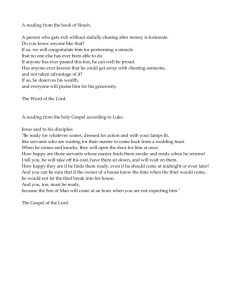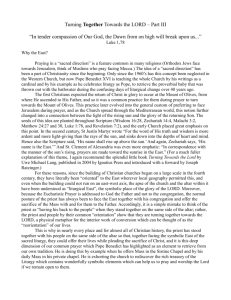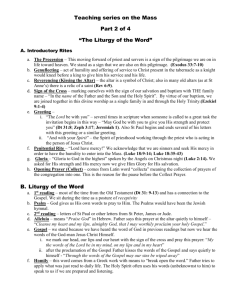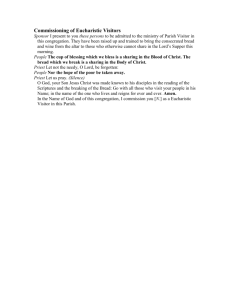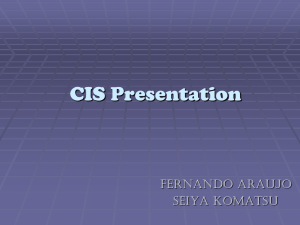- Holy Spirit Catholic Church
advertisement
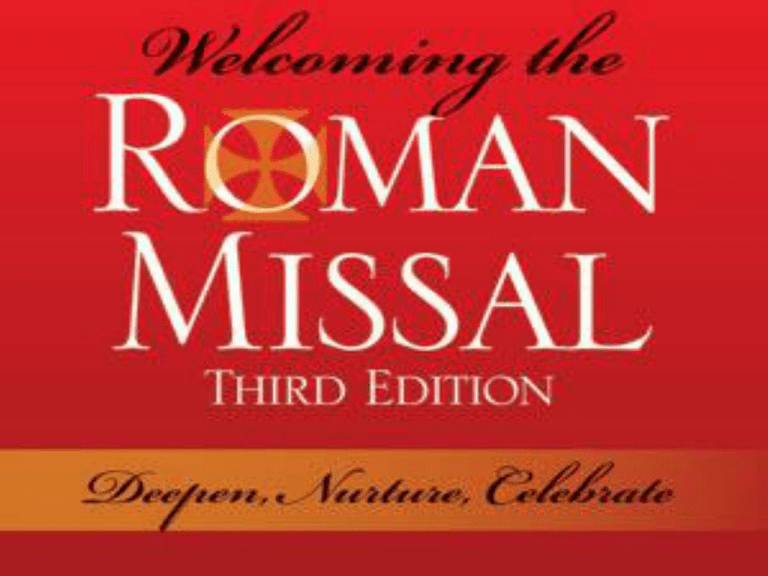
The flow of the Mass is not changing at all It will still take place in 4 parts: Introductory Rites Liturgy of the Word Liturgy of the Eucharist Concluding Rites I. INTRODUCTORY RITES: 1) Entrance Chant (or possibly an Antiphon for weekday Mass) 2) Sign of the Cross and greeting Immediately after the Sign of the Cross, the celebrant (priest) extends one of three different liturgical greetings to the people. By far, the most common one used is: “The Lord be with you.” This will remain unchanged with the new translation. However, our new response will be the first change in the Order of Mass. Instead of responding “And also with you”, we will now be saying: “And with your spirit” This new response will also be made at four other times during the Mass when this dialogue of “The Lord be with you…” occurs. The second time will be during the reading of the Gospel. And at the beginning of the Eucharistic prayer. Also, during the Sign of Peace. And finally, at the conclusion of Mass. Why the change? The first reason is: “And with your spirit” is the proper translation of the original Latin text: “Et cum spiritu tuo”.. By correctly expressing this dialogue in English, we are actually aligning our translation with that of all the other major language groups, which have long been translating the Latin properly. But even beyond the linguistic reason, the recovery of the word “spirit” also carries scriptural meaning. The two parts of this greeting express a desire that the Lord be present to the spirit of the entire community. Both the greeting and the reply come from the Bible. “The Lord be with you” appears as a greeting or encouragement in Judges 6:12, Ruth 2:4, Chronicles 15:2 and Luke 1:28. In Luke 1:28, the greeting given by the Archangel Gabriel to Mary at the Annunciation: “Hail, favored one! The Lord is with you.” “And with your spirit” is inspired by passages that conclude four of the New Testament epistles: 2 Timothy 4:22, Galatians 6:18, Philippians 4:23 and Philemon 25. The dialogue establishes the interdependence of the priest and the people, as they take up their roles to praise God. 3) Penitential Act: There are 3 options for the Penitential Act. The priest invites the faithful by saying: “Brethren (brothers and sisters), let us acknowledge our sins, and so prepare ourselves to celebrate the sacred mysteries.” a) The first option for the Penitential Act, Option A, and the most common one used on Sunday, is called the Confiteor. Confiteor is Latin for “I confess”, and comes from the first line of the prayer. As you are know, it begins with: “I confess to almighty God and to you my brothers and sisters…” There will be a new translation of some of the words in this prayer. (Refer to your handout) Remember, the guiding principle of the new translation is a closer adherence to the original words in Latin. The new translation for this prayer has us express more grandly the seriousness of our sin and the sincerity of our contrition. Most of this text remains the same as the version we presently use. However, there are two key modifications. The first replaces our current wording of “I have sinned through my own fault” with “I have greatly sinned.” The new text reflects the Latin wording by incorporating the adverb “nimis,” which means “very much.” The second set of changes occurs about halfway through the Confiteor, and is more significant. The words removed from the first section (“through my own fault”) are being returned to their proper place here, but with the expression’s full content. “Through my fault, through my fault, through my most grievous fault” is a direct translation of the Latin phrase “mea culpa, mea culpa, mea maxima culpa.” As a well-known line from the old Latin Mass, “mea culpa” has even become a familiar part of our secular parlance, by which one admits having made a mistake. Some might wonder, why this seemingly heavier emphasis on sin in the revised English Confiteor? Looking beyond simple fidelity to the Latin, language that calls to mind our fallen human nature is actually very important in the Sacred Liturgy. The great Apostle of Christ, St. Paul, spoke of his complete and continual reliance on God’s grace in vivid terms well after his conversion: “Christ Jesus came into the world to save sinners. Of these I am the foremost” (1 Tim 1:15). It is good to acknowledge our sinfulness at particular times, just as we should do at sacramental Confession. Unlike Reconciliation, we are not sacramentally absolved of our sins at this point during the Holy Mass. Nevertheless, it is an appropriate way to “prepare ourselves to celebrate the sacred mysteries,” as the Priest says at the beginning of the Penitential Act. We must strive to approach the altar of God with humble dispositions, and should receive the Most Holy Body and Blood of Christ free from grave sin, and in a worthy fashion, as St. Paul exhorts us in 1 Corinthians 11:23-29. During the Confiteor, the faithful should “strike their breast” while saying, “through my fault, through my fault, through my most grievous fault.” This prescribed “striking” is a symbolic tapping of the chest with a clenched fist over one’s heart, signifying remorse. This is part of the beauty of our Catholic liturgy – sacramental words are complemented by sacramental actions. This action also recalls the penitent tax collector in Luke, chapter 18, who “beat his breast and prayed, ‘O God, be merciful to me a sinner.’” Towards the end of the Confiteor we ask for the prayers of the rest of the assembly and the Saints, led by the Blessed Virgin Mary, whose sinlessness and humility are the perfect model for our own Christian lives. Then, as before, the priest says: “May almighty God have mercy on us, forgive us our sins, and bring us to everlasting life.” You respond: “Amen.” The confiteor prayer still concludes with the “Lord, have mercy” ,“Christ, have mercy”, “Lord, have mercy” or the optional “Kyrie, eleison” “Christie, eleison” “Kyrie, eleison. b) The second option, Option B, is one that is rarely used. (Refer to your handout) The first phrase of the new translation is from Baruch 3:2 and the second comes from Psalm 85:8. Then, as before, the priest says: “May almighty God have mercy on us, forgive us our sins, and bring us to everlasting life.” You respond: “Amen.” Then it is followed by the “Lord, have mercy. Christ have mercy. Lord have Mercy.” or “Kyrie, eleison…” c) The third option, Option C, has seven different formulas that may be used. The most common one used is: The priest says: “You were sent to heal the contrite of heart, Lord have mercy.” “You came to call sinners, Christ have mercy.” “You are seated at the right hand of the Father to intercede for us, Lord have mercy”. Just as before, all of these verses are to be followed by the congregation responding: “Lord, have mercy” or “Kyrie, eleison.” The priest concludes with the words: “May almighty God have mercy on us, forgive us our sins, and bring us to everlasting life.” No words have changed for this conclusion to the Penitential Act. 4) Gloria: One of the biggest changes you’ll notice is the words of the Gloria. We will still sing it or recite it on all Sundays of the year except for those during Advent and Lent and the rare occasions when All Souls Day (November 2) falls on a Sunday. Everyone will continue to recite or sing the Gloria, or the people may alternate with the choir, or the choir may sing it alone. The text of the Gloria has changed so much that composers have written new and revised existing musical settings for it. Parishes who sing it, will be learning one or more new revised versions. Since the same text repeats Sunday after Sunday, we will have the opportunity to practice a new setting for many weeks until it feels comfortable. The chart shows you how the text of this hymn has changed: (Refer to your handout) Much of the text of the Gloria comes from Scripture. The first lines are derived from the Angels heralding the glad tidings of Christ’s birth in Luke 2:14: “Glory to God in the highest and peace to those on whom his favor rests.” These opening words “Glory to God in the highest” also correspond to the Latin “Gloria in excelsis Deo”. The revised translation changed “peace to his people on earth” to “on earth peace to people of good will.” Again, the guiding principle for all translations is to let the English express more literally the sentiments of the Latin original. In this case, the previous text describes to whom the people belong (“his” = “God’s”), whereas the new one describes their quality (“of good will”). The new translation of the Gloria is a richer reference to the fact that the Messiah’s coming brings the world a higher order of divine peace that only the incarnate Son of God can bestow. Those who live in accordance with God’s will and receive His grace shall experience the fullness of this peace. Turning to the second sentence of the new Gloria, we notice something striking – the new translation recovers entire phrases that were left out of the current translation. Right now, we sing, “we worship you, we give you thanks, we praise you for your glory.” However, the Latin text of the hymn offers five successive ways in which we should pay homage to God: “We praise you, we bless you, we adore you, we glorify you, we give you thanks for your great In a general sense, it is true that these all convey the same idea of worshiping God, however, the liturgical prayer is enhanced by poetic repetition. And these five descriptions of worship have subtle distinctions. Together, they combine to express the extent to which it is our Christian duty to give “glory to God.” We are in awe in the presence of God and the overwhelming experience of meeting God in prayer. Next change is the words “Only Begotten Son….Son of the Father” represent a slight change from the previous version of: “only Son of the Father”. The new version recovers a key phrase of the Latin text – “Fili Unigenite”. This is a venerable title of Jesus Christ, which speaks of the fact that the Son of God comes forth from the Father, yet is no less an eternal Person of the Divine Trinity. Next, the new text includes two lines (rather than one) that begin with the words “you take away the sins of the world”, thereby reflecting the Latin text. The phrases appear in a different order in the new translation to imitate the order of the words in Latin. By regaining this line and an additional “have mercy on us” in the next line, the new translation features a classic threefold structure of supplication: “have mercy on us… receive our prayer… have mercy on us.” We also see this sort of structure in the Kyrie and Lamb of God. Also, a small change appears in this line. We have been singing about “sin” in the singular, but the new translation has “sins” in the plural. The difference indicates that Jesus takes away not just generic sin from the world, but individual sin. He forgives people their personal sins. This revised translation for the Gloria reflects the long tradition of this hymn, while making it suitable for singing. It roots us in the scriptures, gives us words to praise God, and is an occasion to reflect on the forgiving power of Jesus Christ. 5) Opening Prayer or Collect: The Introductory Rites conclude with the Opening Prayer of the Mass. The Opening Prayers (Collects) have been retranslated. II) The Liturgy of the Word There are virtually no changes to the words we use for the Liturgy of the Word, except for some words in the Creed. 1) Scripture readings and Homily: The first two readings will conclude the same way. At the end of the reading the reader will say: “The Word of the Lord” and everyone answers “Thanks be to God.” One change that you will probably never notice because these words are said in silence by the priest or deacon. These are the words that are said in silence which precede and conclude the proclamation of the Gospel. In fact there are several times during the Mass that the priest and deacon say some prayers in a low or inaudible voice. They are saying these prayers to center their minds on the meaning of their actions. One change will be when the priest or deacon is standing at the ambo and greets you with the words: “The Lord be with you”, your response will now be “And with your spirit”, which is the same response at the beginning of the Mass that we already have went over. When the Gospel is announced by the priest or deacon: “A reading from the Holy Gospel according to Matthew (or Mark or Luke or John)”, the old response was “Glory to you Lord”. It is now “Glory to you, O Lord” The word “O” has been added throughout the Missal before words such as “Lord” and “God” in sentences that are prayers.. At the conclusion of the Gospel, the congregation will continue to respond “Praise to You, Lord Jesus Christ.” The scripture readings will still be in the separate books entitled Lectionary for Mass and The Book of the Gospels. For the homily, the priest or deacon will still observe the same expectations for its preparation. And just like before, you will typically hear a homily based on the scripture readings for the day. 2) The Profession of Faith: Of course our faith is staying the same, but some of the words we use to profess our faith when we pray the Creed (Nicene or Apostles) are changing. You will notice that there are more changes in this text than in any other words you say at Mass. Once again, the guiding principle for the revised translation has been to make the English closer to the Latin original. The translators have given us a text that expresses our common faith with more precision. Catholics profess the Creed each Sunday in various languages around the world and it is important that we all say the same words because there is one faith. The Creed the people in the U.S. usually proclaim is the Nicene Creed. (refer to your handout) You will notice right away that the Creed begins with “I” instead of “We”. The Creed is still the faith of the entire Church, but each of us proclaims it to assert our personal faith together with other believers. “I believe” is a literal translation of the Latin word “Credo”, and it is consistent with the translation that has been used in many other countries around the world since the Second Vatican Council. You will notice this change from “we” to “I” in other parts of the Creed. Next, changing the words from “of all that is seen and unseen” to “of all things visible and invisible”. This makes it a little more precise because some things that are visible by nature are actually unseen at certain places and times. For example, your relatives who live across the country are visible, but unseen to you. Next, the word “only” is replaced by “Only Begotten”. They translate the Latin more fully. They reaffirm that Jesus did not merely materialize as the Son of God, but that He was intentionally begotten; His presence has always been part of the divine plan. Next, the words “eternally begotten of the Father” are replaced by “Born of the Father before all ages”. This makes it more precise. Jesus dwelled with the Father before time began. This reminds us of the first two verses of the Gospel of John: “In the beginning was the Word, and the Word was with God, and the Word was God. He was in the beginning with God.” To say the Son is “born of the Father before all ages” is a profound theological truth, for the Son is not “born” in the human sense of beginning one’s life, but eternally proceeds from the Father while being always fully God. Therefore, we profess that Jesus Christ is “begotten, not made.” These verses from the prologue or introduction to the Gospel of John, are a poem prefacing the account of Jesus Christ’s life on earth, proclaiming and praising his divinity and eternity. Jesus is the uncreated Word, God the Only-Begotten. Next, the words “one in being with the Father” are replaced with the word “consubstantial with the Father”. This describes the relationship between Jesus and the Father. This word lies closer to the Latin equivalent consubstantialis, which means having the same substance, which is more fundamental than “one in being”. “Consubstantial” is a term that teaches that the three persons of the Trinity, while distinct and separate, share one and the same substance. Next, the word “born” is replaced by the word “incarnate”. It professes our faith that the Word became flesh in the womb of the Virgin Mary. Our previous translation could possibly be misunderstood to state that the Word became flesh when Jesus was born. The revised translation makes it clearer that Jesus did not become a human at the moment He was born; He was incarnate in the womb, and in that event “became man.” Next, the words “suffered, died” is replaced by “suffered death”. This is closer to the Latin text. Next, the words “in fulfillment” is replaced with the word “in accordance.” Next, the word “worshipped” is replaced with the word “adored”. Once again, it more closely resembles the word in Latin. Next, the words “we acknowledge” is replaced with the words “I confess”. In this context, “confess” means profess belief in. It is better than “acknowledge” because it involves the heart and not just the Next, the words “We look for the resurrection” are replaces by the words “I look forward to the resurrection”. Once again, this is a clearer translation of the Latin and also it resounds confidence. 3) Prayers of the Faithful (General Intercessions): The entire text of the Prayer of the Faithful can be freely composed in our local Church community knowing best what the community should pray for, although the petitions are supposed to cover four areas. These areas are: the needs of the Church, public authorities and/or the salvation of the world, those burdened by any kind of difficulty, our community. There are sample petitions in the new Roman Missal. III) The Liturgy of the Eucharist 1) The Preparation of the Gifts: The Liturgy of the Eucharist begins with the Preparation of the Gifts. There will be only be very few changes to the words. On Sundays, a hymn is sung as the gifts are collected and the altar is prepared. The Missal calls this music the offertory chant. There are no changes for this. Once the priest has received the gifts and stands at the altar, he praises God, who has provided the gifts. Because there is an offertory chant, the priest will say the words of praise to God quietly. For weekday Masses, the priest says these words in an audible voice. The words of the priest will be very slightly different. As he raises the bread which will soon become the body of Christ, he will say quietly or audibly: “Blessed are you, Lord God of all creation…” Your response will still be the same: “Blessed be God forever.” The priest will then raise the chalice with the wine which will soon become the blood of Christ and he will say audibly: “Blessed are you, Lord God of all creation…” Your response will still be the same: “Blessed be God forever.” 2) Invitation to Prayer Then, after the priest washes his hands, he invites you to pray. His invitation is slightly different. He will say: “Pray, brethren (brothers and sisters), that my sacrifice and yours, may be acceptable to God, the Almighty Father.” The difference in words from “our sacrifice” to “my sacrifice and yours” is a reminder that each member of the assembly is offering a sacrifice, in keeping with his or her priestly role as a baptized member of the Church. Your response to prayer is changed by the addition of one word: “May the Lord accept the sacrifice at your hands for the praise and glory of his name, for our good and the good of all his holy Church.” The word holy appears in Latin, so it is being added to the English. The reason that the Lord will hear the prayer and accept the sacrifice of the humble priest is because of the holiness of the Church. The addition of the word “holy” reminds us that the Church belongs to Christ, and is founded on His grace. 3) Next, is the Prayer over the Gifts: As you know, there are different prayers over the gifts and a different one is used most every week. This will not change. Some of the words will change to offer a richer and fuller content. You will still respond ‘Amen’ at the end of the prayer. 4) Eucharistic Prayer: The Eucharistic Prayer is the center and summit of the entire Mass. It is a prayer of thanksgiving and sanctification. a) Just as before, the Eucharistic prayer begins with a dialogue between the priest and the people called: Preface Dialogue. The priest says: “The Lord be with you” and you respond: “And with your spirit.” The priest then invites you to lift up your heart in prayer and give thanks to God (“Lift up your hearts”), as you unite your thoughts with those expressed by the priest. You still respond: “We lift them up to the Lord.” Then the priest says “Let us give thanks to the Lord our God” and you respond: “It is right and just”, which is closer to the Latin. This is a simple rendering of the Latin: “Dignum et iustum est”, emphasizing the fact that is fitting and appropriate to give thanks to the Lord. The word eucharist means thanksgiving. In this dialogue at the beginning of the Eucharistic prayer, the priest invites you to ‘give thanks’ and you declare that it is right and just to do so. b) Then the priest says the Preface in the name of the entire community using the appropriate preface in which the marvelous deeds of God are proclaimed. And at the end of the Preface, we join the choirs of angels in singing their song, the Sanctus (Holy, Holy, Holy). The Holy, Holy, Holy, comes at a significant moment in the Mass. We are praising God. We are acknowledging the wonderful things God has done, and we are proclaiming how holy God is. Most all of the Sanctus stays the same except for a slight change in the first line of the acclamation. The change of words is from “Holy, Holy, Holy, God of power and might” to “Holy, Holy, Holy God of hosts”. The first line of the Holy, Holy, Holy, is based on a passage from the Book of Isaiah (6:1-3) and the Gospel of Luke (2:13). The replacement word, hosts, means the angelic hosts, the invisible powers that work at God’s command. The revised translation emphasizes the sublime power of God, who has all the forces of nature under control. (And speaking of the sublime power of God, shortly after this hymn, the priest, by the spirit given him at ordination, acts in the person of Christ (in persona Christi) and asks the Holy Spirit to exercise that power of God, by changing the bread and wine into the Body and Blood of Christ.) There is no change to the rest of this acclamation. It continues to quote the crowds in Jerusalem, who shout “Hosanna” to Jesus at his triumphant entry on Palm Sunday (Matthew 21:9). The crowds in this Gospel story also quote Psalm 118:26, “Blessed is he who comes in the name of the Lord.” So, as we can see, the Holy, Holy, Holy, affirms the Divinity of Christ, the unity of testimony in the Old and New Testaments, the holiness of God, the power of God over all forces, and the universal desire of all creation to raise a voice together to praise God. The Sanctus reminds us that all creatures in “heaven and earth” owe thanksgiving to God. As the Angels are present and worshipping with us as we celebrate the Holy Eucharist, with every fiber of our being should reflect the utmost reverence. Therefore, immediately after the Sanctus, we kneel. c) Then the priest prays either Eucharistic prayer I, II, III, or IV. - Eucharistic prayer I is the Roman Canon. - Eucharistic prayer II is the most common used for weekday Mass. - Eucharistic prayer III is the most common used for Sunday Mass. - Eucharistic prayer IV is the least common one used. There will be a new translation of some of the words in this prayer. Again, the guiding principle of the new translation is a closer adherence to the original words in Latin. During the Eucharistic prayer II, III, or IV, that the congregation makes a response to is ‘The Memorial Acclamation’ or more accurately called ‘An Acclamation of Faith’ or “Mystery of Faith’. In the past, the priest has said: “Let us proclaim the mystery of faith” and then the congregation responded with one of the 4 different responses. With the revised missal, rather than saying “Let us proclaim the mystery of faith”, the priest will now simply say “The mystery of faith”. There are several reasons for this. First, again a closer adherence to the Latin. Secondly, the new words are more similar in structure to other parts of the Mass. For example, “The Word of the Lord”, “The Gospel of the Lord”, “The Body of Christ”, “The Blood of Christ”. These are simple, faith filled statements that prompt a response. Thirdly, the prior words of “Let us…” spoken by the priest encouraged the priest to make the acclamation with the congregation. However, the acclamation is the people’s to make. The priest is not supposed to join you in it, any more than he should make the “amen” response after he says “The Body of Christ.” The priest makes the announcement “The mystery of faith”, and you make the acclamation. Something to note is that an acclamation is addressed to someone, whereas a proclamation is made about someone. Our words acclaim Christ; our actions proclaim our faith in Christ. That is why we will now have three acclamations from which to choose instead of four. These three are based on the three Latin acclamations. The three we will use resemble the three we know well, but their deeper meaning is being revealed. One of the four acclamations will be removed because it is a more of a proclamation than an acclamation and also because there is no fourth Latin acclamation. It is perhaps the best known one and one that will be missed: “Christ has died, Christ is risen, Christ will come again.” Again, it makes a statement of faith about Christ (proclamation), rather than a prayer to Him (acclamation). Let’s look at the word changes in the other three. (refer to your handout) Again, it is a closer adherence to the Latin. In the second one, you will notice that there is almost no change. And in the third one, it is mostly just a word order change. All three of them are rich and beautiful and are rooted in scripture. Option A and option B are derived from 1 Corinthians 11:26 – “For as often as you eat this bread and drink the cup, you proclaim the death of the Lord until he comes.” And Christ’s title in option C is found in John 4:42. In regards to the musical settings for the memorial acclamation, we are familiar with several musical settings. New compositions and revised settings are ready to roll out. 4) The Communion Rite: the rituals surrounding the sharing of Holy Communion are not changing, but some of the words will change. The Communion Rite begins with the Lord’s prayer (The Our Father) and continues through the ‘Prayer after Communion’. a) The Lord’s prayer: The Lord’s prayer does not change. Some of the words that the priest uses to introduce the Lord’s prayer have changed: “At the Savior’s command, and formed by divine teaching, we dare to say”. . . Then the Lord’s prayer starts. After the Lord’s prayer, the priest will say his prayer in which there are a few change of words: “Deliver us, Lord, we pray, from every evil…” You still respond with the same words: “For the kingdom, the power, and the glory are yours now and forever.” b) Sign of Peace: After the Lord’s prayer, the priest prays to Jesus for peace and unity in the Church. The text is slightly different, but you will recognize it: “Lord Jesus Christ, who said to your Apostles, Peace I leave you, my peace I give you, look not on our sins, but on the faith of your Church, and graciously grant her peace and unity in accordance with your will. Who live and reign for ever and ever.” You will notice that pronouns referring to the Church are now feminine, like the word “her” in this prayer. This is to recall the Church’s image as the bride of Christ. Your response at the end of this prayer is still: “Amen” Then the priest will greet you just as he does now: “The peace of the Lord be with you always” and your response will be the same new response as in other parts of the Mass: “And with your spirit”. The priest will then invite you to share peace in the same words you have been hearing: “Let us offer each other the sign of peace”. c) Lamb of God: Next is the Lamb of God prayer which is said or sung. The words are not changing for this prayer. Then, the priest elevates the Body and Blood of Christ and announces: “Behold the Lamb of God, behold him who takes away the sins of the world. Blessed are those called to the supper of the Lamb.” As you can see, instead of saying “This is the Lamb of God”, the priest will say “Behold the Lamb of God”. This is closer to the Latin and is more majestic in sound and it is a more direct allusion to John 1:29, where John the Baptist points out Jesus to his followers. This recovery of the word ‘Behold’ also evokes the words of Pilate to the crowd in presenting the scourged Jesus: “Behold the man” (Ecce homo – John 19:5). The Holy Eucharist is a re-presentation of that same sacrificial Victim, and our undertaking in it is a foretaste of the heavenly banquet of the Lamb (Rev 19:9). The word “Happy” has been changed to “Blessed”. You may be blessed even when you are experiencing sorrow. This change, together with the explicit reference to “the supper of the Lamb”, makes clear allusion to Revelation 19:9. There, the angel in the vision has John write down the words that proclaim blessed are those called to the wedding banquet of the Lamb. The response has two changes. First, “Lord, I am not worthy to receive you…” becomes “Lord, I am not worthy that you should enter under my roof…”. This makes a more direct connection with Matthew 8:8 and Luke 7:6, where a Gentile centurion has asked Jesus to heal his paralyzed servant. Jesus intends to go to the house, but the centurion believes himself unworthy to have Jesus come to his home and says: “Lord I am not worthy to have you enter under my roof; only say the word and my servant will be healed.” By quoting the centurion, we are telling Jesus about our unworthiness on account of our sin, and also our need for sincere humility before receiving Holy Communion. And as the Gospel continues, Jesus works the cure because the centurion’s humility overrides any sinful condition of his. We are imitating his humility, so that Jesus will not avoid us because of our sins, but will come to us on the strength of our virtue. The other change to this text is from “I” to “my soul”. We currently say “but only say the word and I shall be healed.” We will now say: “but only say the word and my soul shall be healed.” It shows we are not asking for a generic healing or even a physical healing, but rather for a spiritual healing that alone can cure our soul. (The first translation of the Roman Missal used other words for ‘soul’ in many parts of the Sacramentary. But ‘soul’ is being restored wherever it appears in Latin) d) Holy Communion: When you receive Holy Communion, there will be no change to the words. You will hear: “The Body of Christ” and “The Blood of Christ” and you will respond “Amen” to each. If you are singing a Communion chant or song, there will be no change to the rules for its selection, so you should not notice a change in music for this part of the Mass. e) Prayer after Communion: The priest will say: “Let us pray” and then he will say the prayer. Some of the words of some of the different Prayers after Communion have changed. Just as before, it concludes with your response of “Amen”. f) The Concluding Rites: If there are any brief announcements, they are said. The priest will then greet you as before with “The Lord be with you” and you will reply “And with your spirit” Then he will give the final blessing. Then he will give the dismissal. And for the dismissal, our current three dismissal options will be replaced by four dismissal options: “Go forth, the Mass has ended” or “Go and announce the Gospel of the Lord” or “Go in peace, glorifying the Lord by your life” or “Go in peace”. This reminds us that when Mass concludes, we do not just leave the Church, but rather we enter the world with a mission, emphasizing our Christian call to “mission”. After the priest’s dismissal, your response is the same, ending the Mass with words of joy: “Thanks be to God”. We give thanks to God for the inestimable gift in the Holy Mass, and a means by which He draws us and the entire world into closer communion with him. For the closing hymn, there will be no change. God Bless, The Priests at Holy Spirit Church

